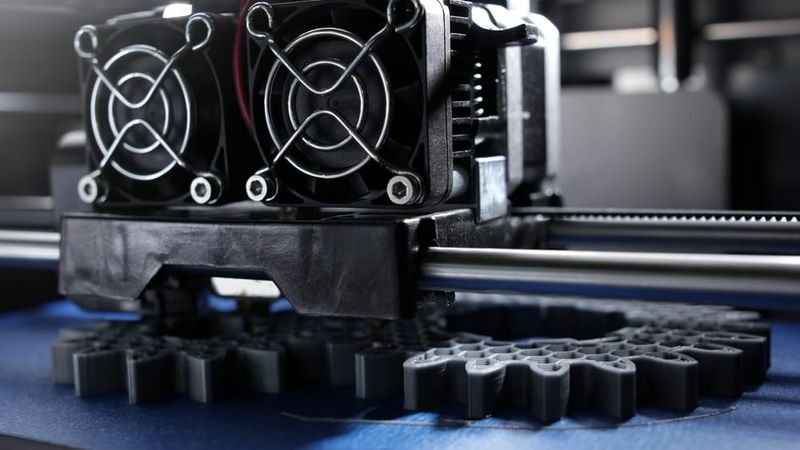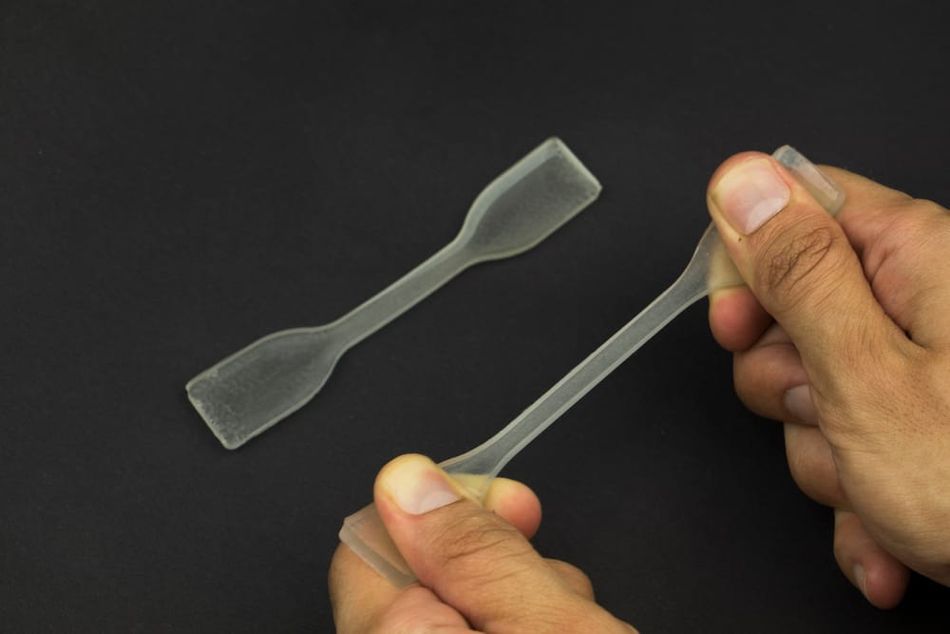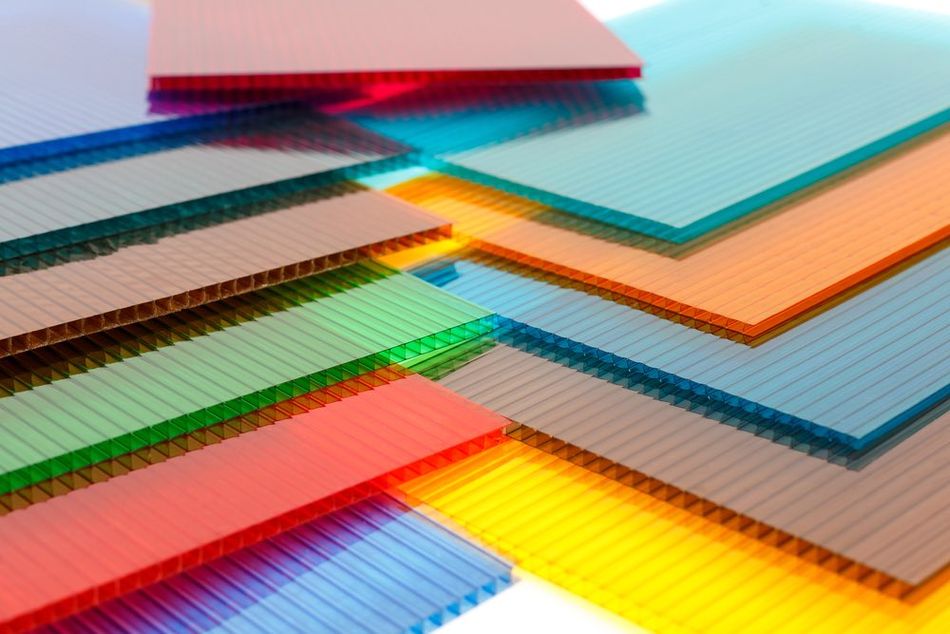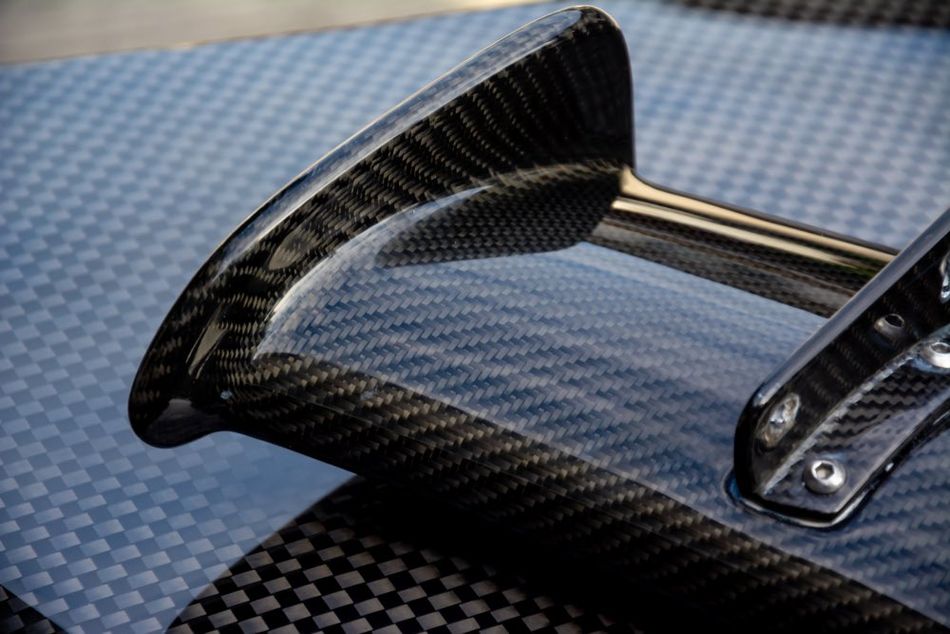Strongest 3D Printer Filament: Choosing Between PC, Nylon, TPU, and Others
When choosing between 3D printer filaments, strength is often a deciding factor. So what is the strongest 3D printer filament? And what does “strength” really mean here?

Strong materials are required for mechanical parts
Good 3D printing materials tend to offer a mix of desirable characteristics. These characteristics can include printability, durability, chemical resistance, temperature resistance, and flexibility, to name just a few. Chief among these desirable properties, however, is strength: nobody wants their 3D printed parts to break, and getting the strongest 3D printer filament available is one of the best ways to ensure this doesn’t happen.
Take a look at the filament market and it’s easy to see that the strongest 3D printer filament from a given retailer costs more than its weaker counterparts. This is partly due to the cost of the stronger raw materials, and partly due to the increased use of 3D printing as a tool for end-use manufacturing, where professional and industrial customers can afford to pay high prices for the best products. Of course, end-use functional parts (GOOD) require greater strength than prototypes, and with demand for high-strength materials growing, many manufacturers have been happy to provide solutions.
This article looks at some candidates that could be considered the strongest 3D printer filament available to regular users of FDM 3D printers. It is by no means an exhaustive guide to high-strength materials, but it takes a look at some of the most popular high-strength filaments in the consumer sphere, while also touching on some professional-grade materials reserved for advanced users.
Different Measurements of Strength
Strong 3D printing filament is in high demand, but “strength” can actually mean a few different things in this context. When comparing filaments, you’ll see terms like tensile strength, impact strength, tear strength, and flexural strength — all of which can be measured using standardized strength tests — in addition to more general terms like durability and toughness.
These different terms are needed because materials can be strong or weak in different ways. For example, try to imagine the relative strength of a glass bottle and a piece of chewing gum. If you were to hurl the two objects at a wall, the glass would obviously break and the chewing gum would survive almost unscathed. But you could much more easily pull the chewing gum apart with your hands than you could the glass bottle.
All of the various strength-related attributes are important when it comes to choosing and buying 3D printer filament. However, two types of strength are generally prioritized over any other. These are tensile strength and impact strength.
Tensile Strength

Used to indicate the ultimate strength of a material or part, tensile strength can be defined as the ability to resist breakage when under tension, i.e. when being pulled or stretched.
Tensile strength is the most widely used indicator of strength for 3D printed parts, because it indicates a material’s suitability for load-bearing or mechanical applications. It is expressed in megapascals (MPa) or, in the United States, in pounds per square inch (psi), and values are determined by performing a tensile test: literally pulling a piece of the material apart and using a tensometer to record the exact degree of tension at which the material breaks. It is a key metric for almost any functional printed part.
Another material characteristic, "Elongation at break," is related to tensile strength and refers to how much a material stretches before it breaks when under tension. Unlike tensile strength, this characteristic is expressed as a percentage.
At the low-cost consumer level, the strongest 3D printer filaments in terms of tensile strength include polycarbonate (PC), polyethylene terephthalate glycol-modified (PETG), and polylactic acid (PLA). Weak materials include thermoplastic polyurethane (TPU) and acrylonitrile butadiene styrene (ABS).
Impact Strength
Another key indicator of strength is impact strength. Synonymous with toughness, impact strength is the ability of a material or part to absorb shock and sudden impact without breaking. It is an important material property for items like safety equipment and children’s toys.
Impact strength is defined as the amount of energy — generally expressed in kilojoules per square meter (kJ/m2) — that the material is able to absorb without breaking. Brittle materials have a low level of impact strength and can break more easily when subjected to sudden impact. However, materials can have a high impact strength and a low tensile strength, and vice versa.
Unfortunately, due to the many different ways of testing for impact strength, it can be difficult to compare the exact toughnesses of two different filaments side by side. Two different filament manufacturers might use different testing methods and even different units of measurement.
At the consumer level, the strongest 3D printer filaments in terms of impact resistance include ABS filament, PETG filament, PC filament, and flexible filaments like TPU. One very weak material in terms of impact strength is PLA, which can easily shatter if it is dropped or struck.
Flexural Strength
Flexural strength, also known as bending strength, measures a material's ability to withstand bending and deformation under load. It is especially important for applications where a material or part is subjected to bending or flexing forces, such as beams, brackets, or structural components.
Flexural strength is typically expressed in megapascals (MPa) and is determined through a standardized testing procedure known as the three-point bend test. In this test, a specimen of the material is placed horizontally on supports, and a load is applied to the center of the specimen until it fractures. The flexural strength is then calculated based on the applied load and the dimensions of the specimen.
Materials with high flexural strength are less likely to deform or break when subjected to bending loads. Common 3D printing filaments with good flexural strength include PC, nylon, and certain types of fiberglass-reinforced filaments.
Tear Strength

Tear strength, also referred to as tear resistance, is a measure of a material's ability to resist the propagation of a tear or crack once it has started. It is particularly relevant for materials used in applications where the material may experience tearing forces, such as fabric, gaskets, or flexible enclosures.
Tear strength is typically measured in kilonewtons per meter (kN/m) or pounds per inch (lb/in) and is determined through a tear resistance test, in which a sample of the material is subjected to a controlled tearing force, and the force required to propagate the tear is measured. Higher tear strength values indicate better resistance to tearing.
Flexible filaments like TPU are known for their good tear resistance, making them suitable for applications where flexibility and durability are essential.
Strongest 3D Printer Filament Candidates
Below are some of the strongest 3D printer filaments available for FDM 3D printing according to the different measures of strength defined above. Note that some of the strongest filaments on the market can only be printed on very expensive professional-grade hardware, so our list skews toward the strongest commercially available filaments that can be bought and used by the average consumer.
Polycarbonate

Approx tensile strength: 70 MPa
One of the strongest FDM 3D printing materials — in terms of both tensile strength[1] and impact strength — is polycarbonate (PC). In fact, polycarbonate filament would likely be one of the most popular printing materials were it not so difficult to print.
Advantages of polycarbonate, besides its excellent tensile and impact strength, include its temperature resistance and its suitability for printing transparent parts. An obstacle to the printing of PC is its very high melting point and the very high temperatures required to print it. Extruder temperatures of at least 260 °C are required, with some formulations needing more than 300 °C, which is beyond the capabilities of consumer-level desktop 3D printers. A bed temperature of around 100 °C is recommended.
Some brands of PC contain additives that reduce the material’s melting point, but these additives can also compromise the material’s strength and heat resistance, making them less suitable for end-use parts such as automotive components.
PC 3D printing is usually limited to non-budget systems that can print at high temperatures and extract the best strength properties from the material. However, even these systems can struggle to control the material’s proneness to warping.
Popular PC filaments include Raise3D Premium PC, Polymaker PolyMax, and 3DXTech 3DXMax PC.
Nylon
Approx tensile strength: 50–80 MPa
Another strong filament in both the tensile strength and impact strength departments is nylon (PA). Although not as robust as PC, nylon filament is marginally easier to print, requiring an extruder temperature of around 250 °C and a heated bed set to around 80 °C.
Nylon is perhaps more often associated with selective laser sintering (SLS) (GOOD) where it is used in powder form to make industrial parts and prototypes. However, nylon FDM 3D printer filament is widely available and typically comes at a lower price point than PC. Compared to PC, it is slightly more flexible, which may be desirable for certain functional parts. Other advantages of nylon filament include its excellent durability, surface smoothness, and layer adhesion.
Although most desktop printers can process nylon filament, the high-strength material has drawbacks. For example, it is highly hygroscopic and prone to absorbing moisture, which can cause a variety of printing issues, such as the formation of bubbles in the nozzle. Like PC, nylon is also susceptible to warping as it cools down.
Popular nylon filaments include MatterHackers Pro Series Nylon, Ultimaker Nylon, and ColorFabb PA.
TPU
Approx tensile strength: 20–50 MPa
Though not usually thought of as high-strength materials due to their very low tensile strength, flexible filaments like thermoplastic polyurethane (TPU) actually offer a very high level of impact strength, making them suitable for shock-absorbing printed objects and functional parts like protective enclosures. Naturally, TPU has a very high elongation at break compared to more rigid materials, and the material also has good abrasion resistance and chemical resistance. Its tensile strength, however, is very low, making it unsuitable for mechanical parts.
Most desktop 3D printers can print TPU and other varieties of thermoplastic elastomer (TPE), with a hot end temperature of around 230 °C required. However, note the best 3D printers for printing flexible filaments have direct-drive extruders, as Bowden extruders can suffer filament tangles.
Popular TPU filaments include NinjaTek Cheetah TPU, Polymaker PolyFlex, and Fillamentum Flexfill.
Recommended reading: TPU print settings explained (GOOD)
High-Performance Polymers
In professional and industrial settings, many FDM users are now turning to high-performance materials like PAEK (PEEK and PEKK) and PEI (ULTEM) for the production of end-use parts, especially in demanding industries like automotive and aerospace. When filament strength is the highest priority, these engineering-grade materials are far better than ordinary products like PLA filament.
High-performance plastics offer a very high level of tensile strength. PEEK filament, for example, can have a tensile strength as high as 100 MPa, notably higher than PC filament and significantly higher than ABS filament. Materials in the PAEK family also have very good impact strength; PEI is slightly less tough, but is typically much more affordable than PAEK filament.
The obvious drawback of high-performance polymers is that they cannot be printed on beginner-level printers or even mid-level desktop machines. They demand much higher temperatures (nozzle, bed, and enclosure) than regular materials, are more expensive, and sometimes require annealing to maximize their mechanical performance.[2]
Popular high-performance filaments include 3DXTECH ThermaX PEEK and Markforged ULTEM 9085.
Composites

The strength and stiffness of thermoplastics can be increased by mixing them with reinforcing additives, creating what is called a composite filament. Common additives include chopped carbon fiber and fiberglass.
Composites are popular in FDM 3D printing because they enable users to incorporate strong materials like carbon fiber without adjusting the printing process. Because there is a greater amount of thermoplastic than additive in the composite, the material can still be melted and extruded like an ordinary filament.
Typically, carbon fiber reinforced filaments are based on common thermoplastics, such as PLA, ABS, PETG, or nylon, with the addition of 10% to 30% carbon fibers by weight. The resulting composite material exhibits a significant improvement in strength and rigidity compared to its base thermoplastic. For example, carbon fiber reinforced PLA can have a tensile strength of up to 100 MPa, compared to around 50 MPa for standard PLA. Meanwhile a product like MatterHackers NylonX (a composite of nylon and carbon fiber) also offers a tensile strength of 100 MPa, higher than the 50–80 MPa of ordinary nylon.
Note, however, that FDM carbon fiber filaments have limits on their strength, because the chopped fibers mixed into the material are randomly oriented. Advanced composite printing technologies, such as those developed by Markforged and Desktop Metal, are able to print continuous fibers, resulting in much stronger parts.[3] Furthermore, reinforcing materials like fiberglass and carbon fibers can cause damage to an ordinary brass nozzle.
Other Ways to Increase Strength
Choosing the strongest 3D printer filament won't guarantee strong parts without careful consideration of your next steps. Here are a few other factors to consider when seeking maximum strength:
Increase Infill Density: Adjust the infill density in your 3D printing slicer software to create a denser interior structure. Higher infill percentages result in stronger parts, although this may increase material usage and printing time.
Modify Layer Orientation: Experiment with the orientation of your printed parts. Adjusting the layer orientation can impact the strength of your prints, with layers printed perpendicular to the applied load often being stronger.
Optimize Wall Thickness: Increase the thickness of outer shells and walls in your 3D modelto add structural integrity to your parts. A thicker shell can enhance the overall strength.
Adjust Print Speed and Temperature: Fine-tune your 3D printer settings, including print speed and temperature. Slower print speeds and higher printing temperatures can improve layer adhesion and part strength.
Use Proper Cooling: Ensure that your cooling settings are suitable for the filament. Cooling can help prevent warping and improve layer bonding, resulting in stronger prints.
Employ Layer Bonding Techniques: Apply bonding techniques such as using an acetone vapor bath for ABS prints or epoxy resin for strengthening critical joints or connections.
Post-Processing: After printing, consider other post-processing techniques like annealing or plating with additional materials.
Design for Structural Support: Optimize your 3D model for strength by incorporating features like ribs, gussets, or thicker cross-sections at load-bearing areas. This design approach can distribute stress more effectively.
Key Takeaways
Choosing the strongest 3D printer filament for your needs comes down to two key factors: the type of strength required and the level of strength required (that is feasible with the printing hardware available).
If the parts need to withstand constant loads and stresses, then materials with a high tensile strength should be prioritized. These include PLA and PETG at the cheaper end, materials like PC in the middle, and composites or high-performance polymers — offering the very highest levels of tensile strength — at the premium end.
If the parts need to withstand sudden impact, then materials with a high impact strength or toughness should be prioritized. Such materials include ABS and TPU at the consumer end and high-performance polymers at the premium end.
In general, materials like nylon and polycarbonate are favored by many FDM users because they offer a good balance between affordability, tensile strength, and impact strength.
Frequently Asked Questions
What is the strongest 3D printer filament?
There is no single "strongest" filament, as different materials offer various strengths and weaknesses. Polycarbonate, carbon fiber reinforced filaments, nylon, and polyetherimide are among the strongest materials available for 3D printing, each with its own set of advantages and disadvantages.
How can I improve the strength of my 3D printed objects?
After choosing a strong filament, one way to further improve the strength of a part is by using a dense infill and high-strength infill pattern, as well as applying post-processing methods like annealing. Another factor to consider is interlayer bonding: layers will adhere together better when printed at the higher end of the appropriate temperature range, resulting in parts that are stronger along the Z-axis.
Can I print with strong filaments on any 3D printer?
Not all 3D printers are capable of printing with strong filaments, especially those requiring high extrusion, chamber, and nozzle temperatures. Check to see if your printer can handle the required temperatures for a given filament, as well as whether it has the necessary hardware, such as a heated bed and a hardened steel or ruby nozzle.
How do I store strong filaments to maintain their quality?
Store filaments in a cool, dry place, away from direct sunlight. Use airtight containers with desiccants to prevent moisture absorption, especially for hygroscopic materials like nylon and polycarbonate.
References
[1] Tanikella NG, Wittbrodt B, Pearce JM. Tensile strength of commercial polymer materials for fused filament fabrication 3D printing. Additive Manufacturing. 2017 May 1;15:40-7.
[2] Yi N, Davies R, Chaplin A, McCutchion P, Ghita O. Slow and fast crystallising poly aryl ether ketones (PAEKs) in 3D printing: Crystallisation kinetics, morphology, and mechanical properties. Additive Manufacturing. 2021 Mar 1;39:101843.
[3] Yang C, Tian X, Liu T, Cao Y, Li D. 3D printing for continuous fiber reinforced thermoplastic composites: mechanism and performance . Rapid Prototyping Journal. 2017 Jan 16.
